1993 PONTIAC BONNEVILLE mirror
[x] Cancel search: mirrorPage 168 of 322
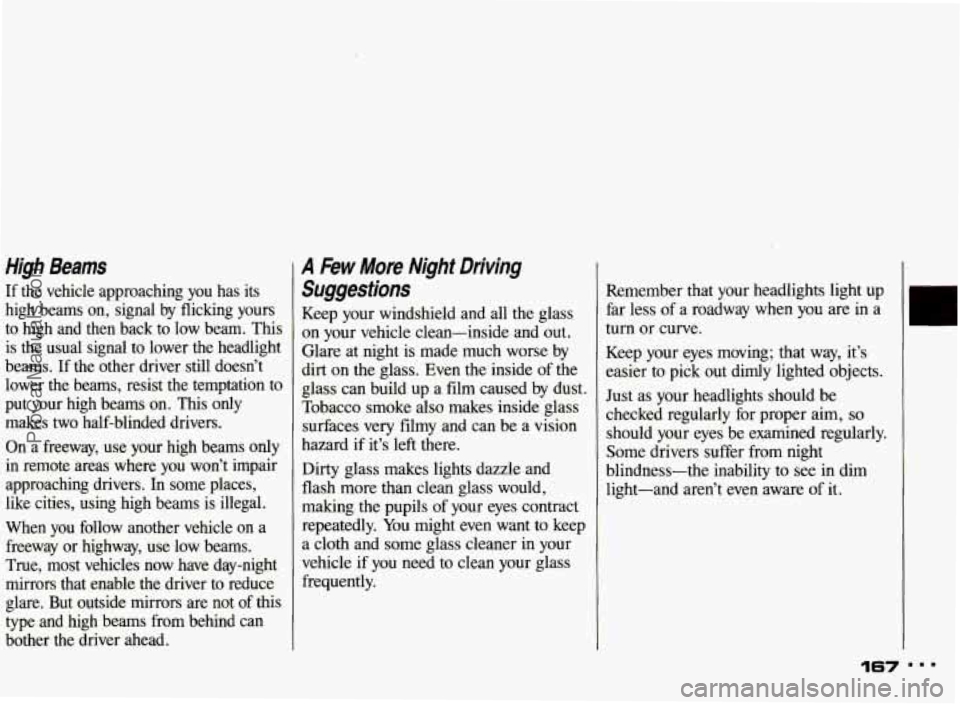
High Beams
If the vehicle approaching you has its
high beams
on, signal by flicking yours
to high and then back to low beam. This
is the usual signal to lower the headlight
beams. If the other driver still doesn’t
lower the beams, resist the temptation to
put your high beams
on. This only
makes two half-blinded drivers.
On a freeway, use your high beams only
in remote areas where you won’t impair
approaching drivers.
In some places,
like cities, using high beams is illegal.
When
you follow another vehicle on a
freeway or highway, use low beams.
True, most vehicles now have day-night
mirrors that enable the driver to reduce
glare. But outside mirrors are not of this
type and high beams from behind can
bother the driver ahead.
A Few More Night Driving
Suggestions
Keep your windshield and all the glass
on your vehicle clean-inside and out.
Glare at night is made much worse by
dirt on the glass. Even the inside
of the
glass can build up a film caused by dust.
Tobacco smoke also makes inside glass
surfaces very filmy and can be a vision
hazard if it’s
left there.
Dirty glass makes lights dazzle and
flash more than clean glass would,
making the pupils of your eyes contract
repeatedly. You might even want to keep
a cloth and some glass cleaner in your
vehicle if you need to clean your glass
frequently. Remember that your headlights light up
far less of a roadway when you are in a
turn or curve.
Keep your eyes moving; that way, it’s
easier to pick out dimly lighted objects.
Just as your headlights should be
checked regularly for proper aim,
so
should your eyes be examined regularly.
Some drivers suffer from night
blindness-the inability to see in dim
light-and aren’t even aware
of it.
167
ProCarManuals.com
Page 173 of 322

Your Driving and the Road
Fmeway Driving
Mile for mile, freeways (also called
thruways, parkways, expressways, turnpikes,
or superhighways) are the
safest of all roads. But they have
their
own special rules.
The most important advice
on freeway
driving is: Keep up with traffic and keep
to the right. Drive at the same speed
most of the other drivers are driving.
Too-fast or too-slow driving breaks a
smooth traffic flow. Treat the left lane
on a freeway as a passing lane.
Entering the Freeway
At the entrance there is usually a ramp
that leads to the freeway.
If you have a
clear view of the freeway as you drive
along the entrance ramp, you should
begin
to check traffic. Try to determine
where you expect to blend with the
flow.
If traffic is light, you may have no
problem. But if it is heavy, find a gap as
you move along the entering lane and
time your approach. Try to merge into
the gap at close to the prevailing speed.
Switch
on your turn signal, check your
rearview mirrors as you move along,
and glance over your shoulder as often
as necessary. Try to blend smoothly
with
the traffic flow.
Driving on the Freeway
Once you are on the freeway, adjust
your speed to the posted limit or to the
prevailing rate if it’s slower. Stay in the
right lane unless you want to pass.
If
you are on a two-lane freeway, treat the
right lane as the slow lane and the
left
lane as the passing lane.
If you are on a three-lane freeway, treat
the right lane as the slower-speed
through lane, the middle lane as the higher-speed through lane, and the left lane as the passing lane.
Before changing lanes, check your
rearview
mirrors. Then use your turn
signal. Just before you leave the lane,
glance quickly over your shoulder to
make sure there isn’t another vehicle in
your “blind” spot.
... 172
ProCarManuals.com
Page 176 of 322
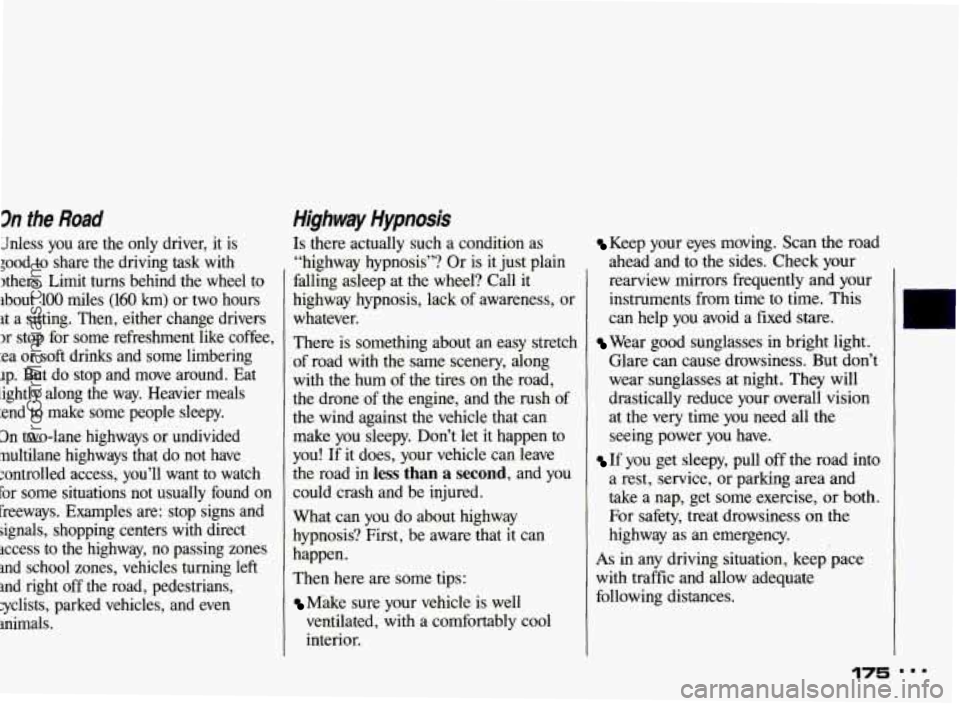
3n the Road
Mess you are the only driver, it is
;ood to share the driving task with
Ithers. Limit turns behind the wheel to
ibout 100 miles
(160 km) or two hours
it a sitting. Then, either change drivers
x stop for some refreshment like coffee,
:ea or
soft drinks and some limbering
lp. But do stop and move around. Eat
lightly along the way. Heavier meals
:end to make some people sleepy.
3n two-lane highways or undivided
multilane highways that do not have
;ontrolled access, you’ll want to watch for some situations not usually found on
freeways. Examples are: stop signs and
signals, shopping centers with direct
access to the highway, no passing zones
and school zones, vehicles turning left
and right off the road, pedestrians,
cyclists, parked vehicles, and even
animals.
Highway Hypnosis
Is there actually such a condition as
“highway hypnosis”? Or is it just plain
falling asleep at the wheel? Call it
highway hypnosis, lack
of awareness, o
whatever.
There is something about an easy stretch
of road with the same scenery, along
with the hum of the tires on the road,
the drone of the engine, and the rush of
the wind against the vehicle that can
make you sleepy. Don’t
let it happen to
you! If it does, your vehicle can leave
the road in
less than a second, and you
could crash and be injured.
What can you do about highway
hypnosis? First, be aware that it can
happen.
Then here are some tips:
Mike sure your vehicle is well
ventilated, with a comfortably cool interior.
Keep your eyes moving. Scan the road
ahead and to the sides. Check your
rearview mirrors frequently and your
instruments from time to time. This
can help you avoid a fixed stare.
Wear good sunglasses in bright light.
Glare can cause drowsiness. But don’t
wear sunglasses at night. They will
drastically reduce your overall vision
at the very time you need all the
seeing power
you have.
If you get sleepy, pull off the road into
a rest, service, or parking area and
take a nap, get some exercise, or both.
For safety, treat drowsiness on the
highway as an emergency.
As in any driving situation, keep pace
with traffic and allow adequate
following distances.
ProCarManuals.com
Page 188 of 322
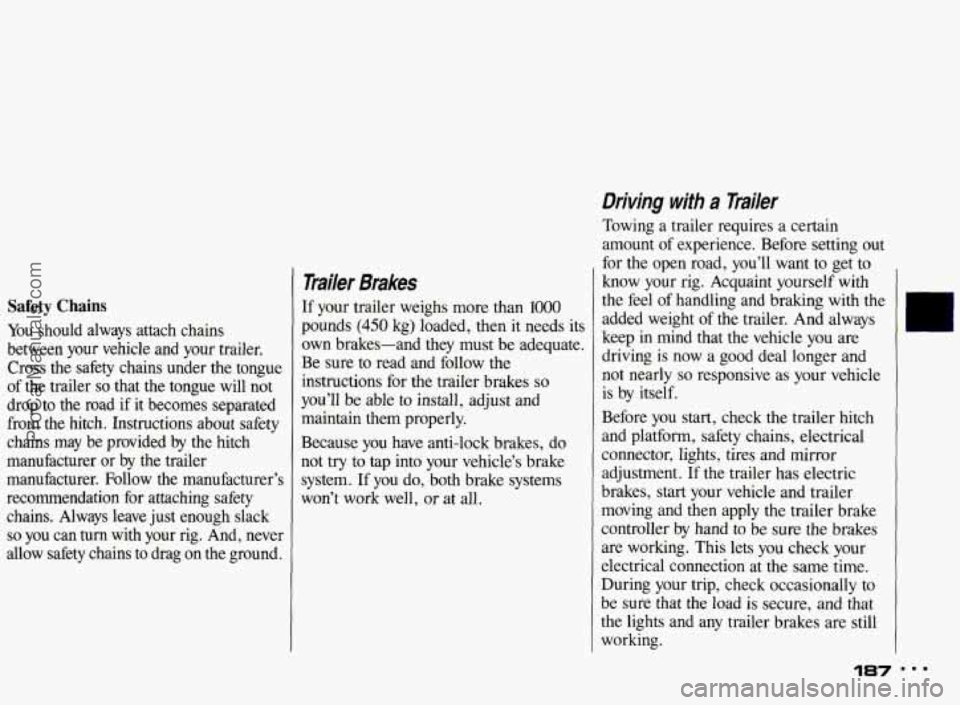
Driving witb a Traiiler
Safety Chains
You should always attach chains
between your vehicle and your trailer.
Cross the safety chains under the tongue
of the trailer
so that the tongue will not
drop to the road if it becomes separated
from the hitch. Instructions about safety
chains may be provided by the hitch
manufacturer or by the trailer
manufacturer. Follow the manufacturer’s
recommendation for attaching safety
chains. Always leave just enough slack
so you can turn with your rig. And, never
allow safety chains
to drag on the ground.
Tiai/er Brakes
If your trailer weighs more than 1000
pounds (450 kg) loaded, then it needs its
own brakes-and they must be adequate.
Be sure to read and follow the
instructions for the trailer brakes
so
you’ll be able to install, adjust and
maintain them properly.
Because you have anti-lock brakes, do
not
try to tap into your vehicle’s brake
system. If you do, both brake systems
won’t work well, or at all. Towing a
trailer requires
a certain
amount of experience. Before setting out
for
the open road, you’ll want to get to
know your rig. Acquaint yourself with I
the feel of handling and braking with the
added weight of the trailer. And always
keep in mind that the vehicle you are
driving
is now a good deal longer and
not nearly
so responsive as your vehicle
is by itself.
Before you
start, check the trailer hitch
and platform, safety chains, electrical
connector, lights, tires and mirror
adjustment.
If the trailer has electric
brakes, start your vehicle and trailer
moving and then apply the trailer brake
controller by hand to be sure the brakes
are working. This lets you check your
electrical connection at the same time.
During your trip, check occasionally to
be sure that the load is secure,
and that
the lights and any trailer brakes are still
working.
ProCarManuals.com
Page 268 of 322
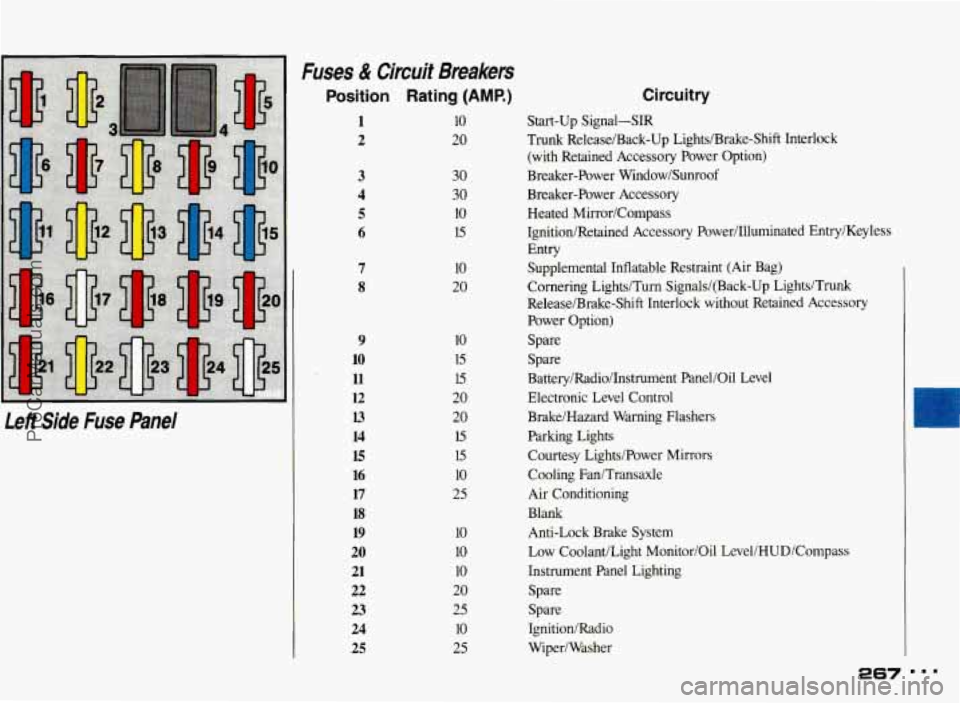
Left Side Fuse Panel Fuses
& Circuit Breakers
Position Rating (AMP.)
7
8
9
10
ll
12
13
14
15
16
17 18
19
20 21
22
23 24
25
10
20
30
30
10
15
10
20
10
15
15
20
20
15
15
10
25
10
10
10
20
25
10
25
Circuitry
Start-up Signal-SIR
Trunk Release/Back-Up Lights/Brake-Shift Interlock (with Retained Accessory Power Option)
Breaker-Power Window/Sunroof
Breaker-Power Accessory Heated Mirror/Compass
IgnitiodRetained Accessory Power/Illuminated EntryKeyless
Entry
Supplemental Inflatable Restraint (Air Bag)
Cornering Lights/Turn Signals/(Back-Up Lights/Trunk
Release/Brake-Shift Interlock without Retained Accessory Power Option)
Spare
Spare
Battery/Radio/Instrument Panel/Oil Level
Electronic Level Control
Brake/Hazard Warning Flashers Parking Lights Courtesy Lights/Power Mirrors
CooIing Fan/Transaxle
Air Conditioning
Blank Anti-Lock Brake System Low Coolant/Light Monitor/Oil Level/HUD/Compass
Instrument Panel Lighting Spare
Spare
IgnitiodRadio
WipedWasher
267
ProCarManuals.com
Page 313 of 322
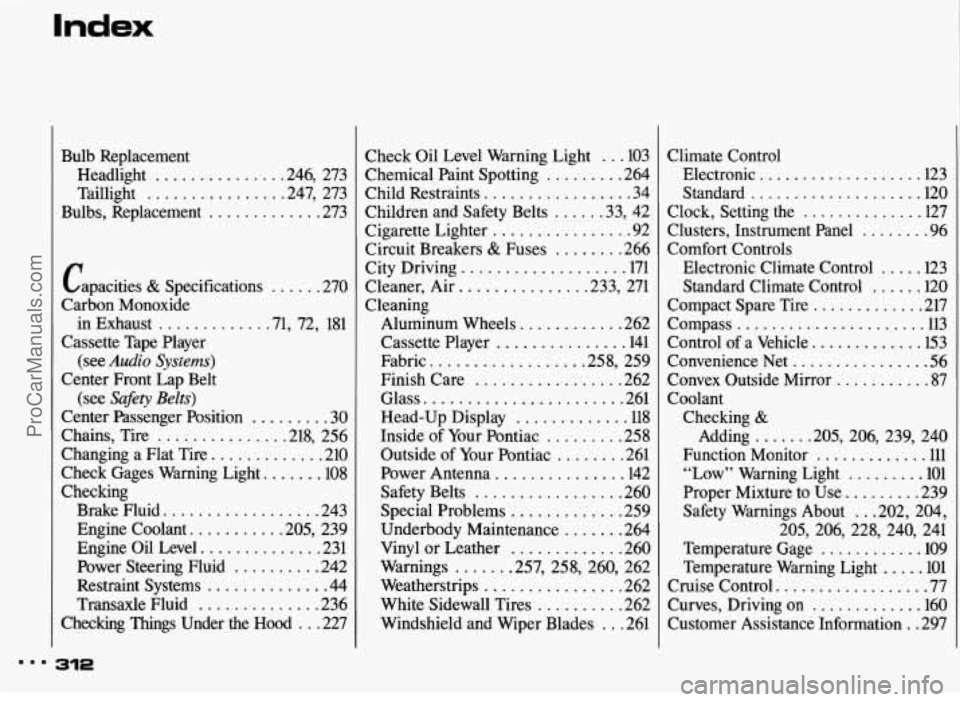
Index
..I
Bulb Replacement
Headlight
.............. .246. 273
Taillight
............... .247. 273
Bulbs. Replacement
............. 273
Capacities
& Specifications ...... 270
Carbon Monoxide
in Exhaust
............ .71. 72. 181
Cassette Tape Player
(see
Audio Systems)
Center Front Lap Belt
(see
Safety Belts)
Center Passenger Position ......... 30
Chains. Tire
.............. .218. 256
Changing a Flat Tire
............. 210
Check Gages Warning Light
....... 108
Checking
Brake Fluid
.................. 243
Engine Coolant
.......... .205, 239
Engine
Oil Level .............. 231
Power Steering Fluid
.......... 242
Transaxle Fluid
.............. 236
Restraint Systems
.............. 44
Checking
Things Under the Hood ... 227
312
Check Oil Level Warning Light ... 103
Child Restraints
................. 34
Children and Safety Belts
..... .33. 42
Cigarette Lighter
................ 92
Circuit Breakers
& Fuses ........ 266
City Driving
................... 171
Cleaner. Air
.............. .233, 271
Cleaning Aluminum Wheels
............ 262
Cassette Player
............... 141
Fabric
.................. 258. 259
Finish Care
................. 262
Glass
....................... 2.61
Head-Up Display
............. 118
Inside
of Your Pontiac ......... 258
Outside
of Your Pontiac ........ 261
Power Antenna
.............. -142
Safety Belts
................. 260
Special Problems
............. 259
Underbody Maintenance
....... 264
Vinyl or Leather
............. 260
Warnings
...... .257. 258. 260. 262
Weatherstrips
................ 262
White Sidewall Tires
.......... 262
Windshield and Wiper Blades
... 261
Chemical
Paint Spotting
......... 264 Climate Control
Electronic ................... 123
Standard
.................... 120
Clock. Setting the
.............. 127
Clusters. Instrument Panel
........ 96
Comfort Controls
Electronic Climate Control
..... 123
Standard Climate Control
...... 120
Compact Spare Tire
............. 217
Compass
...................... 113
Control of a Vehicle
............. 153
Convenience Net
................ 56
Convex Outside Mirror ........... 87
Coolant
Checking
&
Function Monitor ............. 111
“Low” Warning Light
......... 101
Proper Mixture to Use ......... 239
Safety Warnings About
.. .202. 204.
205. 206. 228. 240. 241
Temperature Gage
............ 109
Temperature Warning Light
..... 101
Cruise Control
.................. 77
Curves. Driving on
............. 160
Customer Assistance Information
. . 297
Adding
...... .205. 206. 239.
240
ProCarManuals.com
Page 316 of 322

Hood Release .................. 227
Safety Warning
.. .194. 195. ’ 204. 228
Warning. Overheated Engine
... .196.
204.205.206.228.240. 241
Horn
......................... 72
Hot Engine. Safety Warnings
.... .196.
204.205.206.228.240. 241
How the Anti-Lock Brake
System Works
............... -156
Hydroplaning
.................. 169
Identification Number. Vehicle
.... 264
If You’re Stuck in Sand. Mud.
Ignition Idling Your Engine
........... .70.
72
Ice. or Snow
................. 218
Key
......................... 46
Positions
..................... 57
Illuminated Entry
................ 55
Inflation. Tires
................ 250
Indicator Lights (see
Warning
Lights)
Infant Restraint (see Child Restraints)
Inside Rearview Mirror .......... 86
Instrument Panel
................ 94
Instrument Panel Clusters
......... 96
Instrument Panel Warning Lights ... 99
Intensity Control
................ 84
.................... J ack. Tire 211
Jump Starting
.................. 193
Keyless Entry. Remote
........... 49
Keys
.......................... 46
Lamp Monitor
................. 112
Lane Change Indicator
............ 72
Lap-Shoulder Safety Belt
.......... 19
Front
....................... 30
Rear
........................ 31
Use by Children
............... 33
Light Controls
.................. 81
Lighters
....................... 92
Air Bag System
............... 24
Daytime Running Lights
......... 83
Fog Lights
................... 85
Headlights
............ .81, 83, 246
“On” Reminder
............... 82
Lights Parking
...................... 81
Reading
..................... 85
Removing
& Replacing
Bulbs
............ .246. 247. 273
Replacement Bulbs
............ 273
Taillights
............... .247. 273
Turn Signal
................... 74
Underhood
.................. 228
Warning Lights
............... 100
Loading Your Vehicle
............ 248
Locks
......................... 47
Locks. Rear Door Security
........ 50
Locks. Remote Control ........... 48
Long Distance Driving
........... 174
Low Battery
................... 193
Low Fuel Warning
.............. 109
Low Oil Pressure Warning
........ 102
Low Washer Fluid Warning Light
................ 105
Lubricants & Fluids ......... 272
Maintenance Record
........... 294
Maintenance Schedule
........... 275
Maintenance Services. Scheduled
. . 278
Malfunction Indicator Lamp
...... 104
ProCarManuals.com
Page 317 of 322
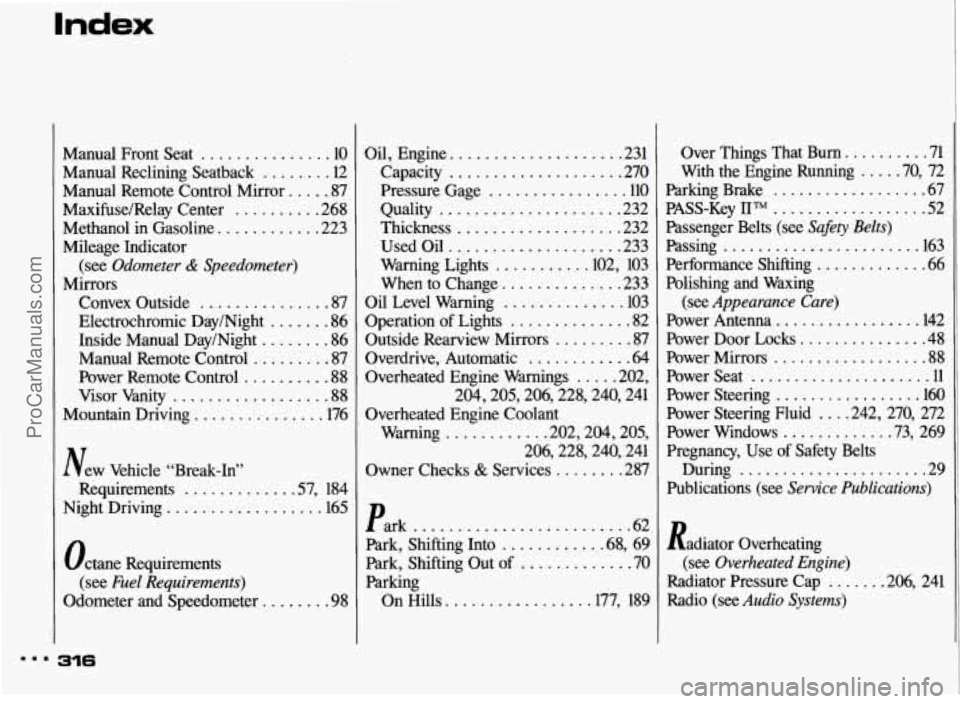
Index
Manual Front Seat ............... 10
Manual Reclining Seatback
........ 12
Manual Remote Control Mirror ..... 87
Maxifuse/Relay Center .......... 268
Methanol in Gasoline
............ 223
Mileage Indicator
Mirrors (see
Odometer & Speedometer)
Convex Outside ............... 87
Electrochromic Day/Night
....... 86
Inside Manual Day/Night
........ 86
Manual Remote Control
......... 87
Power Remote Control
.......... 88
Visor Vanity .................. 88
Mountain Driving ............... 176
New Vehicle “Break-In”
Requirements
............ .57. 184
Night Driving
.................. 165
octane Requirements
Odometer and Speedometer
........ 98
(see Fuel Requirements)
Oil. Engine .................... 231
Capacity
.................... 270
Pressure Gage
................ 110
Quality
..................... 232
Thickness
................... 232
Used Oil .................... 233
Warning Lights
.......... .102. 103
When to Change
.............. 233
Oil Level Warning
.............. 103
Operation of Lights
.............. 82
Outside Rearview Mirrors
......... 87
Overdrive. Automatic
............ 64
Overheated Engine Warnings
.... .202.
204.205.206.228.240. 241
Overheated Engine Coolant Warning
........... .202.204.205.
206.228.240. 241
Owner Checks
& Services ........ 287
Park
................. 1 ....... 62
Park. Shifting Into ........... .68. 69
Park. Shifting Out of
............. 70
Parking On Hills
................ .177. 189 Over
Things That Burn .......... 71
With the Engine Running
.... .70. 72
Parking Brake
.................. 67
PASS-Key
IITM .................. 52
Passenger Belts (see
Safety Belts)
Passing ....................... 163
Performance Shifting
............. 66
Polishing and Waxing
Power Antenna
................. 142
Power Door Locks
............... 48
Power Mirrors
.................. 88
Power Seat
..................... 11
Power Steering
................. 160
Power Steering Fluid
... .242. 270, 272
Power Windows
............ .73. 269
Pregnancy. Use
of Safety Belts
During
...................... 29
Publications (see
Service Publications)
(see Appearance Care)
Radiator Overheating
(see
Overheated Engine)
Radiator Pressure Cap ...... .206. 241
Radio
(see Audio Systems)
... 316
ProCarManuals.com